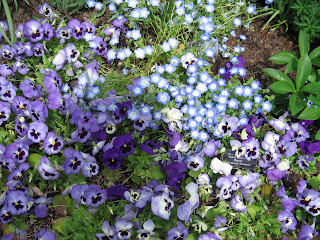Pansies: The Flowers with Faces





We've been talking about pansies on the Garden Book Club board at BN.com, so I dug out this article that I wrote about five years ago. The information still applies:
Pansies are sometimes considered an old-time flower favorite because they have been around for years and they never really go away. Kids like them because of their friendly flower “faces,” while garden lovers favor them because they will bloom even when winter’s chill is in the air. Whether they are planted in a solid mass of a single color, or a vibrant mix of many-colored flowers, pansies are a welcome sight in early spring, when bulbs are about the only other flowers in bloom. Landscape contractors like pansies because they can plant them in beds, borders and even baskets and they will look good for weeks at a time, during the transition from spring to summer.
Pansies and violets are often confused, but generally speaking, pansies are annuals and violets are perennials. Both belong to the genus Viola – pansies are Viola × wittrockiana, which may have evolved from the European Viola tricolor. Pansies can act more like tender perennials at times, though, due to the introduction of hybrids and cultivars that are bred to withstand both summer heat and extremes of winter cold. It has been shown that blue and yellow-flowering pansies tend to be the cold-hardiest forms. While violets are delicate, fragrant, petite, and usually violet in color, pansies have bigger, bolder flowers in a much wider range of colors and many color combinations. Pansies aren’t usually planted solely for fragrance, but the yellow and white flowering forms tend to be fragrant.
Pansies are also often associated with “Johnny-jump-ups” (Viola cornuta), tender perennials whose blossoms look like a miniature pansy flower; the cultivar ‘Helen Mount’ is the most popular form. Pansies, violets and Johnny-jump-ups all self-sow, so a repeat crop the following year is often possible even if the original plants don’t survive the winter.
Pansies are suddenly one of the hot “new” flowers, in part because of all the new varieties that are now available. They have become the focus of breeders who compete to introduce the most unusual colors and color combinations. With over 250 cultivars to choose from, there are pansies for just about every need. Another difference with the “new” pansies is that they are being bred to have slightly smaller but more abundant flowers, while in the past the preferred cultivars had fewer but larger flowers. The new, long-blooming pansies will keep blooming well into winter, long after bedding plants have been decimated by hard frosts.
Pansies come in three basic types – multiflora or superflora (smaller-flowered, bushier plants that are cold hardy and bloom for a long time), medium-flower pansies, which include many popular cultivars and several award-winners, and large-flowered pansies that feature large blossoms but aren’t known for their long bloom times.
Deadheading will encourage reblooming, and an application of 15-2-20 fertilizer should be applied in early spring, every two weeks until mid-March or so. After that, a 20-10-20 fertilizer should keep them going strong. Fertilizing is best performed in late fall in warmer areas, and in colder climates, in early spring. Don’t fertilize in late spring or summer, when excess nitrogen can weaken the plants. Do keep newly transplanted pansies well-watered and mulched.
While pansies can survive in alkaline soils, they perform best when the pH is 5.8 or a little lower. Some experts believe that pansies are most likely to thrive if planted when soil temperatures are between 45 and 65 degrees Fahrenheit. Pansies like a spot in sun to filtered shade, where air circulation is good, the soil is rich in organic matter and moist but well-drained. They should not be watered in the afternoon or evening because the plants are vulnerable to rot. As winter approaches, let the soil remain dry for longer periods to help harden the plants.
Originally published in The Landscape Contractor magazine in June 2004
Comments
philippines flower shop